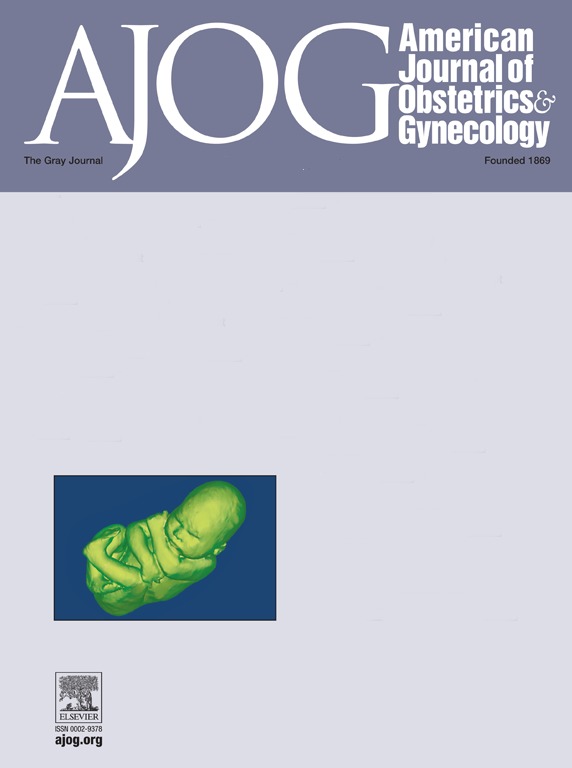Uterine Cancer Diagnosis at Age 65: Onset of Medicare Eligibility and Impact of Medicaid Expansion.
IF 8.4
1区 医学
Q1 OBSTETRICS & GYNECOLOGY
引用次数: 0
Abstract
BACKGROUND Uterine cancer, for which diagnosis is based on evaluation of symptoms, most commonly postmenopausal bleeding, is one of the few cancers in the United States with rising incidence and mortality. Inability to access diagnostic services due to lack of insurance coverage may lead to delayed diagnosis and inferior outcomes. OBJECTIVE The aim of the study was to examine whether the onset of Medicare eligibility at age 65 was associated with a spike in the incidence of uterine cancer and whether this association was attenuated by Medicaid expansion through the Affordable Care Act (ACA). STUDY DESIGN The ecological study used cancer registry data from the Surveillance, Epidemiology, and End Results (SEER) program to estimate the incidence rate of uterine cancer among women aged 55-74 from 2000 to 2021 in the United States. Second order polynomial modeling was used to fit the association between age (in single years) and incidence rate at the population level while excluding age 65 to identify the expected incidence rate at age 65 in the absence of a spike. The expected uterine cancer incidence rate at age 65 was generated from the model and compared to the observed rate at age 65 in the overall sample. Similar analyses were also conducted further stratified by stage, race/ethnicity, pre-ACA (2004-2013) versus post ACA (2014-2021) period and states' Medicaid expansion status. RESULTS In the overall sample, the observed uterine cancer incidence rate at age 65 was 108.2 cases per 100,000 woman-years (95% confidence interval (CI) 106.4-110.1), which exceeded the expected rate projected from the polynomial model (102.5, 95% CI 101.4-103.5). A similar pattern was observed in analysis stratified by stage at diagnosis and by race/ethnicity. The spike in incidence at age 65 diminished in Medicaid expansion states in the post-ACA period but persisted in non-expansion states. CONCLUSION Onset of Medicare eligibility at age 65 was associated with a spike in uterine cancer diagnoses, which appeared to be mitigated by Medicaid expansion. These findings underscore the importance of insurance coverage in facilitating timely uterine cancer diagnoses.65岁子宫癌诊断:医疗保险资格的开始和医疗补助扩张的影响。
背景:原发性癌症的诊断基于对症状的评估,最常见的是绝经后出血,是美国为数不多的发病率和死亡率上升的癌症之一。由于缺乏保险覆盖而无法获得诊断服务,可能导致诊断延误和预后不佳。目的:本研究的目的是研究65岁开始享有医疗保险资格是否与子宫癌发病率激增相关,以及通过平价医疗法案(ACA)扩大医疗补助是否减弱了这种关联。研究设计:生态研究使用来自监测、流行病学和最终结果(SEER)项目的癌症登记数据来估计2000年至2021年美国55-74岁女性子宫癌的发病率。二阶多项式模型用于拟合年龄(单年)与人口水平发病率之间的关系,同时排除65岁以确定65岁时没有高峰的预期发病率。根据该模型得出65岁时子宫癌的预期发病率,并与总体样本中65岁时观察到的发病率进行比较。类似的分析还进一步按阶段、种族/民族、ACA实施前(2004-2013年)与ACA实施后(2014-2021年)以及各州医疗补助扩张状况进行了分层。结果在整个样本中,观察到的65岁子宫癌发病率为108.2例/ 10万妇女年(95%置信区间(CI) 106.4 ~ 110.1),超过了多项式模型预测的预期发病率(102.5,95% CI 101.4 ~ 103.5)。在按诊断阶段和种族/民族分层的分析中观察到类似的模式。在后aca时期,在医疗补助扩大的州,65岁人群的发病率高峰有所下降,但在未扩大的州,这一现象依然存在。结论:65岁开始的医疗保险资格与子宫癌诊断的激增有关,这似乎被医疗补助计划的扩大所缓解。这些发现强调了保险覆盖在促进子宫癌及时诊断中的重要性。
本文章由计算机程序翻译,如有差异,请以英文原文为准。
求助全文
约1分钟内获得全文
求助全文
来源期刊
CiteScore
15.90
自引率
7.10%
发文量
2237
审稿时长
47 days
期刊介绍:
The American Journal of Obstetrics and Gynecology, known as "The Gray Journal," covers the entire spectrum of Obstetrics and Gynecology. It aims to publish original research (clinical and translational), reviews, opinions, video clips, podcasts, and interviews that contribute to understanding health and disease and have the potential to impact the practice of women's healthcare.
Focus Areas:
Diagnosis, Treatment, Prediction, and Prevention: The journal focuses on research related to the diagnosis, treatment, prediction, and prevention of obstetrical and gynecological disorders.
Biology of Reproduction: AJOG publishes work on the biology of reproduction, including studies on reproductive physiology and mechanisms of obstetrical and gynecological diseases.
Content Types:
Original Research: Clinical and translational research articles.
Reviews: Comprehensive reviews providing insights into various aspects of obstetrics and gynecology.
Opinions: Perspectives and opinions on important topics in the field.
Multimedia Content: Video clips, podcasts, and interviews.
Peer Review Process:
All submissions undergo a rigorous peer review process to ensure quality and relevance to the field of obstetrics and gynecology.

 求助内容:
求助内容: 应助结果提醒方式:
应助结果提醒方式:


